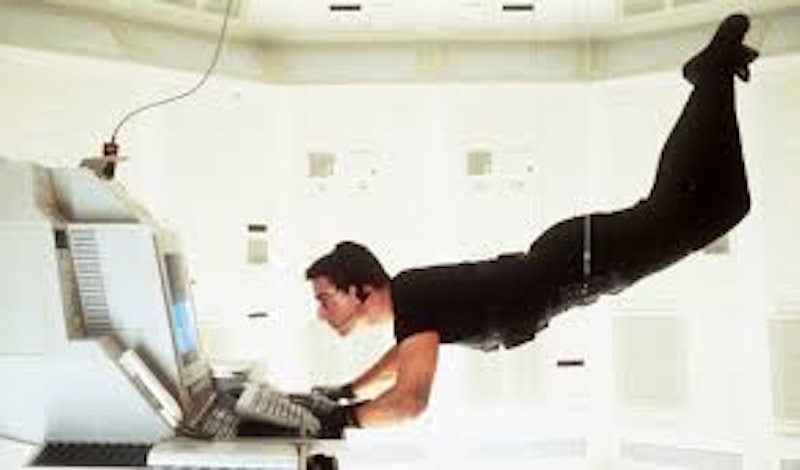The first Mission: Impossible movie made a lot of money, and also got good reviews, so there was every motivation to turn the film into a franchise. A sequel moved forward with Tom Cruise returning as producer and star. John Woo was hired as director. William Goldman was recruited to write the script. And then it went wrong.
Woo decided not to speak English during the making of the film, helping his process but making things tougher on the actors. Cruise apparently felt the stress of his position, and the pressure to make another hit. And Goldman couldn’t get the script to work. Various other writers turned in drafts; in the end Ronald D. Moore and Brannon Braga, producers of various Star Trek spinoffs, got credit for story while Robert Towne returned from the first film to craft the finished screenplay.
Towne was able to develop a script around the action set-pieces Woo had already begun to envision. The film was finally released four years after the first, and made a lot of money, becoming the second highest-grossing movie of the year 2000. Looking back at it, though, the seams show.
The plot: after rogue Impossible Missions Force agent Sean Ambrose (Dougray Scott) steals a newly-developed bioweapon and its cure, good-guy IMF agent Ethan Hunt (Cruise) accepts the mission of tracking him down. Hunt’s boss, an uncredited Anthony Hopkins, orders him to recruit master thief Nyah Nordoff-Hall (Thandiwe Newton, credited here as Thandie Newton); this isn’t because of her thieving skills, but because she and Ambrose used to be an item. By this time, she and Hunt are sleeping together.
Double-dealing occurs as Nyah goes undercover with Ambrose. Hunt kidnaps an evil Big Pharma exec and destroys most of the bioweapon, but Nyah’s injected with the last sample after a shootout with Ambrose. Hunt has to infiltrate a secret base, fight bad guys, kill Ambrose, and get the cure before Nyah dies and infects the people of Sydney, Australia.
Each of the main characters is let down by the script. As a result, while the plot’s functional and the action scenes in the second half are often extraordinary, the movie’s not as engaging as it should be.
We don’t get much background for Ambrose. We don’t know why he flipped on the IMF. We know he used to serve as a double for Hunt, setting up a half-hearted attempt to position him as Hunt’s evil counterpart—and Hollywood loves to have a villain who’s an evil counterpart to the hero. But we don’t know why he does what he does.
Mind you, we don’t really know why Hunt does what he does, either. He’s just as much a cipher here as in the first movie, and in this case he doesn’t have the motivation of seeing a team killed around him. His relationship with Nyah’s supposed to be the emotional hook, but since we don’t know who the guy is it’s difficult to care. He doesn’t seem much like the Ethan Hunt of the first movie.
Nyah betrayed the most by the story. Despite set up as a master thief, she never gets to display any talent. She’s used as a means to manipulate Ambrose, and as someone for Hunt to rescue, and that’s about it.
Woo does his best, trying to invest the rudimentary character beats of the script with the scale of his earlier work, but there isn’t enough substance. His interest in playing about with identity should mesh with a franchise property in which masks and disguises feature prominently, but you only catch glimpses of his pet themes breaking through Hollywood formulas.
In the first Mission: Impossible Brian De Palma found ways to get at his favorite obsessions while crafting a tense thriller. That movie felt like De Palma; for most of its running time, the sequel doesn’t click as a John Woo film.
Mission: Impossible 2 does try to be something different from the first movie, for better or worse. It’s brighter, glossier, with the camera moving much more to create a more kinetic sense. Which is to say it aims at being an action blockbuster. Odd, then, that the action’s late in emerging. Other than a few scenes introducing Hunt and Nyah and setting up their courtship, the first half doesn’t have many thrills. What we do get is lightweight, establishing character and tone but lacking conflict or real drama.
Then in the second half a moderate amount of hell breaks loose. A shootout in a skyscraper gives way to a series of escalating set-pieces, building from fist-fights to gunplay to motorcycle chases with lots of pyro. It’s well-paced, well-structured, and a pleasure to look at.
It also features pigeons fluttering about, a Woo trademark. In this final sequence we see what Woo’s capable of: excellent visual storytelling that uses beautiful violence to build character and tension. It’s been a long time coming, but enough to leave you satisfied as the film ends.
Still, step back to look at the movie as a whole, and it doesn’t hang together. The spy-story in the first half is less engaging than the explosions of the second, and the different tones don’t make a meaningful contrast. It did make money, and that led to a third movie. A viable franchise was now established, based on not much more than a theme song, Tom Cruise, and a few dialogue tics from a half-remembered 1960s TV show. A quarter-century later, we’ve ended up with a series of eight movies that’ve collectively made over 4.5 billion.

